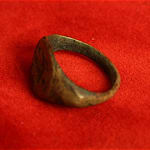Roman Bronze Ring of an Image of a Military Trophy, 100 CE - 300 CE
Bronze
FJ.6721
Further images
Both the Bronze Ring and the Incised Image are Ancient Roman. The art of jewelry-making originated in prehistoric times when primitive people used objects from the animal world—such as horn,...
Both the Bronze Ring and the Incised Image are Ancient Roman.
The art of jewelry-making originated in prehistoric times when primitive people used objects from the animal world—such as horn, shell, and feathers—to adorn themselves. Cave paintings and carvings show figures decorated with bracelets, necklaces, and headdresses. Since then many forms of jewelry have evolved, so that there is hardly a part of the body for which an ornamental form has not been created. Arms and legs have been festooned variously with bracelets, rings, shoe buckles, and ankle bracelets; the head with tiaras, earrings, and combs; and the chest and neck with broaches, necklaces, belts, and breastplates. Traditionally jewelry has been a sign of social rank and a symbol, often of luck or good fortune.
The art of jewelry-making originated in prehistoric times when primitive people used objects from the animal world—such as horn, shell, and feathers—to adorn themselves. Cave paintings and carvings show figures decorated with bracelets, necklaces, and headdresses. Since then many forms of jewelry have evolved, so that there is hardly a part of the body for which an ornamental form has not been created. Arms and legs have been festooned variously with bracelets, rings, shoe buckles, and ankle bracelets; the head with tiaras, earrings, and combs; and the chest and neck with broaches, necklaces, belts, and breastplates. Traditionally jewelry has been a sign of social rank and a symbol, often of luck or good fortune.





